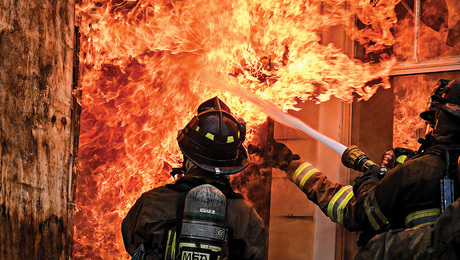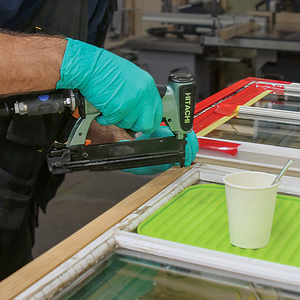I have a question about how to hang DW on a wall with horizontal furring….I’m furring out with 1x3s perpendicular to the studs because the existing wall is somewhat uneven and it’ll allow me to add a little bit of a thermal break….I’m relying on John Wagner’s Drywall book published by Creative Homeowner, which has more on framing for DW than the Taunton book….On page 45 he says that horizontal furring will require horizontal placement of DW panels, which seems backward to me….On page 66 of the Taunton book (citing an article from FHB #98), Ferguson explains that DW should be hung perpendicular to the framing for maximum strength, which in this case would mean vertical….Who is wrong here?
Reading on this topic in the archives, the Breaktime spin appears to be that vertical hanging of panels is better if you’re working alone, although the joints will be more noticeable (horizontal joints easier for the eye to miss?). I assume it’s also easier to avoid butt joints with vertical hanging. I have the impression that one should also make sure that each edge of a panel has framing behind it (which in the case of horizontally hung DW would require blocking that no-one bothers with).
Presumably I’ve got some points wrong here, would welcome being set right…




















Replies
Go perpendicular to the 1x3. No need to have a framing member on the edge of every board..that's nonsense. Just be sure to leave the butt joint on the 1x3. Suggest you use drywall glue, screws on the interior of the sheetrock and you can nail the edge of the board. Oh yes, space the 1 x 3's at 16" on center.
I'm in the process of repairing a 5-year-old house with water damage, and the DW install was as you suggest; nails on the edges and screws in the field. I've never done it that way. What are the advantages?
I never met a tool I didn't like!
the real advantage is ease of install. nail up the sheet then come back and screw the rest after.
Ahh, makes sense. But if you're hanging by yourself, it's tough to hold the sheet up and nail it. I use a Senco belt-fed screw gun so I can hold the sheet in place then screw it off. But I can see the logic in doing it that way if you have a crew.
I never met a tool I didn't like!
Nuke Dat Rock,
A nail holds drywall better than a screw if the nail is in the center of the stud or joist. When you nail the edge of the bottom top board on a wall, you can see the stud below and put the nail right in the middle of the stud. On the top of the upper board, the two 2x4's give you plenty of space to put that nail in the center. In either case, the nail is covered by the tape and you will never see the pop even if it does pop.
In the interiuor of the board, to place the screw in the dead center of the stud is difficult because the stud is hardly ever straight, but a screw will hold better on the edge on the wood than a nail does. You know when you nail near the edge of wood the wood will splinter but the screw will slightly splinter the wood but still grabs better.
As someone also said, it's easier to hang the board when you place the nails on the top edge prior to hanging it..just take your hammer out and whack the nails while holding the board with the other hand.
we fur all our outside walls and ceilings here in Montreal. gyproc is installed pretty much all horizontal on any walls greater than 4' wide. of course some common sense has to be used when hanging it but mostly all horizontal. no blocking at butt joints when furring is at 16" centre never had problem. order all 12' sheets for entire house except in bathrooms. install ceiling first and press wall sheet up to ceiling sheet to get nice straight top corner. if you are alone cut two peices of 2x to jamb under sheet when holding it up. jointers get pissed here if they see vertical joints here too much up and down and more joints.
Why do you furr the outside walls?Joe Carola
oh-oh I knew it was going to happen. maybe we should start another thread on furring. seen it here many of times and the subject has hijacked alot of discussions. i think it is because we have too many trees here in Canada..lol! i say that because i know that is one of the arguments against. i guess first would be our winter climate with the air space helping out the insulation factor, then would be the stiftening of the 2x6 keeping them straighter and not twisting as much(alot of green lumber used here), very easy to install gyproc, do not have to worry about having studs for intersecting interior walls, easy to install extra blocking for window treatments, crown, high baseboard. it is also a great way to fix any lack of quality the framers left behind. alot of reason to furr and alot not to but since i started doing it the time and expense to fur is overshadowed by the ease and quality of job.
we also furr the exterior of the walls over the tyvec!
Your right there's been a lot of discussions but mostly on furring ceilings which I think is a waste of time and is not a more quality job but not much discussion on furring walls which I never heard of furring out walls before on new work and I've also asked guys who furr out ceilings because they think it's better nailing to furr out walls but without hijacking the thread I was just curious about the walls. Knock yourself out furring your walls...;-)Joe Carola
Edited 1/24/2005 11:14 pm ET by Framer
doing a reno in a house built in the early 70's and the ceiling is furred. made it alot easier to have that 3/4" space for retrofitting some overhead lighting.
our truss suppliers even calculate the added straping stenght in their floor and ceiling systems. it is a given here that a house will have straping.
I was glad to see it mentioned in a recent artical in FHB. we have been furring the outside walls for years. IMHO an airspace is just better building
"our truss suppliers even calculate the added straping stenght in their floor and ceiling systems."
Somebody's yanking your chain. Current design standards do not allow for stapping design in floor systems.
The bottom chord of a truss is in tension, so adding strapping wouldn't make any difference.
My life has a superb cast but I can't figure out the plot. [Ashleigh Brilliant]
you are right about the trusses but it is the truss supplier's floor system i was mentioning. they send us their installation instructions that calls for straping on the underside of their floor joists. like their instructions to put blocking or rows of 2x6 in openweb. maybe they're making us do more work to make their system stiffer.
The 2X6s run in wood webbed floor trusses are strongbacks, not strapping. And they make the system STIFFER, not strongerr. You menntion strapping on other types of floor joists, but don't specify what kind of joists you're talking about.
Women need a reason to have sex. Men just need a place. - Billy Crystal
I missed it, did somebody call them strapping? Definetely not strapping. Their pimary reason is to distribute loads over more area of the floor making it stiffer as you and also i mentioned. But i also think they add to the strenght marginally. mostly open web and wooden I-beam.
the difference between strapping and furring is often the locale as in what part of the crountry yur standing in...
proud member of the FOR/FOS club...
Life is not a journey to the grave with the intention of arriving safely in a pretty and well preserved body, but rather to skid in broadside, thoroughly used up, totally worn out, and loudly proclaiming
WOW!!! What a Ride!
i agree
If I can ask a follow-up question: how do people handle blocking when they fur out? I have a sinking feeling when I think about furring out all the 2x blocking I've got. Do you just rely on long screws? Does it depend on what the blocking is for e.g. towel bar vs grab bar?
taylor.. we furr walls 16" oc horizontal for Mooney Wall.. then hang our blueboard horizontal also
Yah I'd like a Mooney wall but I have to leave room to fit a vanity....planning on squeezing 3/4" foam between furring strips, have to do something, there is a lot of sistering of damaged studs....
The butts need solid blocking where as the factory joint does not . There is power or strenth in the running joint and we use that side to span to next unit nailing members. The end joint is the weakest link and should be solid blocked by code.
Your situation would call for standing drywall.
8s can be hung by one person either way just as easy. You need a floor foot kicker either way. Its silly to hold a sheet and set screw it . Nail the edges to secure the hanging process and screw the field. The joints wont give problems if they are double nailed and its much quicker hanging . Rock and roll.
Tim Mooney
Run the sheets vertically, vertical joints are less visible to my eye than horizontal. The strips are horizontal, makes no sense to run rock same way.
mike
no sense to you, maybe....Mike Smith Rhode Island : Design / Build / Repair / Restore